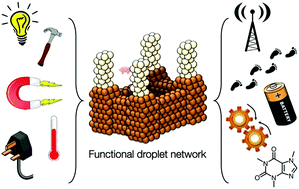当前位置:
X-MOL 学术
›
Mol. Biosyst.
›
论文详情
Our official English website, www.x-mol.net, welcomes your feedback! (Note: you will need to create a separate account there.)
Functional aqueous droplet networks
Molecular BioSystems Pub Date : 2017-07-13 00:00:00 , DOI: 10.1039/c7mb00192d Michael J. Booth 1, 2, 3, 4 , Vanessa Restrepo Schild 1, 2, 3, 4 , Florence G. Downs 1, 2, 3, 4 , Hagan Bayley 1, 2, 3, 4
Molecular BioSystems Pub Date : 2017-07-13 00:00:00 , DOI: 10.1039/c7mb00192d Michael J. Booth 1, 2, 3, 4 , Vanessa Restrepo Schild 1, 2, 3, 4 , Florence G. Downs 1, 2, 3, 4 , Hagan Bayley 1, 2, 3, 4
Affiliation

|
Droplet interface bilayers (DIBs), comprising individual lipid bilayers between pairs of aqueous droplets in an oil, are proving to be a useful tool for studying membrane proteins. Recently, attention has turned to the elaboration of networks of aqueous droplets, connected through functionalized interface bilayers, with collective properties unachievable in droplet pairs. Small 2D collections of droplets have been formed into soft biodevices, which can act as electronic components, light-sensors and batteries. A substantial breakthrough has been the development of a droplet printer, which can create patterned 3D droplet networks of hundreds to thousands of connected droplets. The 3D networks can change shape, or carry electrical signals through defined pathways, or express proteins in response to patterned illumination. We envisage using functional 3D droplet networks as autonomous synthetic tissues or coupling them with cells to repair or enhance the properties of living tissues.
中文翻译:

功能性水滴网络
液滴界面双层(DIB)包含在油中成对的水滴之间的单个脂质双层,被证明是研究膜蛋白的有用工具。近来,注意力已经转移到通过功能化的界面双层连接的,具有在液滴对中无法实现的集体性质的水滴网络的精细化。小型的二维液滴集合已经形成了柔软的生物设备,可以充当电子组件,光传感器和电池。液滴打印机的开发是一项重大突破,它可以创建成百上千个相连液滴的图案化3D液滴网络。3D网络可以改变形状,或通过定义的路径传送电信号,或响应于图案化照明而表达蛋白质。
更新日期:2017-08-02
中文翻译:

功能性水滴网络
液滴界面双层(DIB)包含在油中成对的水滴之间的单个脂质双层,被证明是研究膜蛋白的有用工具。近来,注意力已经转移到通过功能化的界面双层连接的,具有在液滴对中无法实现的集体性质的水滴网络的精细化。小型的二维液滴集合已经形成了柔软的生物设备,可以充当电子组件,光传感器和电池。液滴打印机的开发是一项重大突破,它可以创建成百上千个相连液滴的图案化3D液滴网络。3D网络可以改变形状,或通过定义的路径传送电信号,或响应于图案化照明而表达蛋白质。



























 京公网安备 11010802027423号
京公网安备 11010802027423号